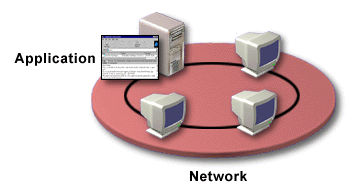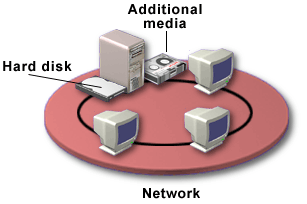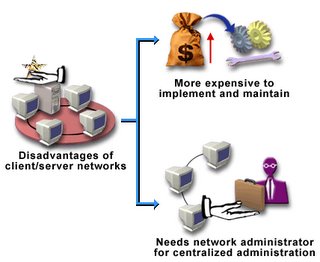Tuesday, May 16, 2006
Friday, May 05, 2006
Friday, April 21, 2006
Servers-Disk Server,File Server,Print Server,Communication Server, Application Server.





In a network, servers need to perform a number of tasks, such as storing data, creating files, and accessing applications. A large network supports dedicated servers for performing specific tasks. The following types of servers are mainly used in a large network.
1.disk server
2.file server
3.print server
4.communication server
5.application server
A disk server shares a hard disk in a network. It is primarily used for storing data in a network. Therefore, in addition to local storage, a client machine has access to some disk space on a disk server. The disk space can be used for taking backups. In addition to hard disk, a disk server can provide storage space by accommodating different data storage media, such as CDs, jazz, zip, cartridge tapes, etc. Clients can choose to store their data on any of these media.
File server provides a central storage mechanism for files. This enables users to store their files in one central location. When a user makes a request for a specific file, the file server sends the file to the user. File servers enable users to create, read, modify, and delete shared files.
A print server makes a printer available to network clients. Since a single printer can be made available to all the clients, clients do not need individual printers
In your network, you might require your microcomputers to communicate with mainframe computers. However, mainframe computers do not run on the same operating systems as microcomputers. In such a situation, a communication server enables the microcomputers to communicate with a mainframe computer. Communication servers typically handle the data flow, e-mail messages, and fax traffic within a network, and with other networks.
An application server enables clients to access software applications that reside on a shared computer. When a user makes a request to the application server, the database stays on the server and only the result of the request is sent to the computer making the request.
Friday, April 14, 2006
Disadvantages of Client/server Networks

Though a client/server network is highly secure and efficient, it has one limitation. Compared to a peer-to-peer network, it is more expensive to implement and maintain a client/server network. This is because client/server networks require expensive and dedicated hardware and software. Moreover, client/server networks need a network administrator as the resources in the network are administered centrally. This involves investing on hiring a network administrator.
Advantages of Client/server Networks

Client/server networks offer certain advantages in the areas of security, administration, and performance. These advantages address most of the limitations of a peer-to-peer network.
Resources are centrally administered in a client/server network. This helps in easy location of resources.
A client/server network offers extensive security. All user accounts and passwords are centrally managed. A server verifies the user account and password, before granting access to the requested resources.
A client/server network is highly scaleable. It can support a large number of users.
The use of dedicated servers ensures faster sharing of network resources.
Client/server Networks

.
A client/server network supports structured access to network resources. Frequently used resources are stored on a separate set of computers, known as dedicated servers.
A dedicated server is a server that is dedicated for providing services to clients. A dedicated server never functions as a client
Disadvantages of Peer-to-peer Networks

A peer-to-peer network imposes certain limitations on the users. Some of the disadvantages are as follows.
The lack of a central administrator leads to difficulty in locating errors. To detect any error, you might need to check various machines on the network.
In a peer-to-peer network, each user must have a password. To access the resources of a user, you must know the password of that user. This requires users to remember multiple passwords.
A peer-to-peer network is non-scalable. It cannot accommodate large number of computers.
Advantages of Peer-to-peer Networks

A peer-to-peer network cannot support a large number of computers.
Therefore, it is only suitable for small organizations. A peer-to-peer network offers many advantages. Listed below are some of the advantages of using a peer-to-peer network.
1.It is simple to design and implement, and easy to maintain.
2.It does not require expensive and dedicated servers as each computer acts both as a client and a server.
Hence, the implementation and maintenance costs are low.
3.There is no central administration of resources in this type of network. All users act as administrators and
manage the security issues involved in their respective computers.
4.It is fault tolerant. Failure of any machine results in the unavailability of only that machine, and not of the entire network.
Peer-to-peer Networks

In a peer-to-peer network, each computer can directly access the hardware and software resources of other computers on the network. Each computer can be a client and a server simultaneously. A peer-to-peer network supports unstructured access to network resources. Each network computer is a peer to all other computers on that network, that is, there is no hierarchy in the network.
A client is a computer that uses network services.
A server is a computer that provides network services.
Thursday, April 13, 2006
LAN-WAN-MAN
LAN
A LAN is a network that facilitates resource sharing and information exchange by connecting computers within a limited area, such as a building or a group of buildings. For instance, you can establish a LAN in an office or a factory.
WAN
With the advancement of modes of communication and technology, business operations started dispersing all over the globe. LANs could not support the network needs of a large business as they could be implemented only in a limited geographical area. This led to the development of WANs. A WAN is a network that spreads over large geographical areas, such as different countries or continents. A WAN enables you to connect a LAN to another remote LAN.
MAN
A MAN is a network that is geographically larger than LAN but comparatively smaller than WAN. A MAN uses LAN technology; it may become large enough to cover a metropolitan area, say, an entire city.
A LAN is a network that facilitates resource sharing and information exchange by connecting computers within a limited area, such as a building or a group of buildings. For instance, you can establish a LAN in an office or a factory.
WAN
With the advancement of modes of communication and technology, business operations started dispersing all over the globe. LANs could not support the network needs of a large business as they could be implemented only in a limited geographical area. This led to the development of WANs. A WAN is a network that spreads over large geographical areas, such as different countries or continents. A WAN enables you to connect a LAN to another remote LAN.
MAN
A MAN is a network that is geographically larger than LAN but comparatively smaller than WAN. A MAN uses LAN technology; it may become large enough to cover a metropolitan area, say, an entire city.
Friday, March 24, 2006
Monday, March 20, 2006
Resource Sharing through a Network

In addition to exchanging information, a network enables you to share resources. Sharing of resources enables you to make applications, equipment, and data of a computer available to other computers on the network. Additionally, resource sharing facilitates better utilization of resources. For instance, you do not need to attach expensive hardware resources, such as printers and fax machines, to each computer. Instead, these resources can be attached to a single computer and made available to other computers in a network
NETWORKING BASIC

Introduction
Modern organizations are widely dispersed with their branches located in different parts of the globe. To facilitate effective communication between different branches and to gain a competitive edge in the market, organizations need to constantly share information. To share information, you can set up a network that connects various computers of your organization, thereby, making their data and hardware resources available to others. A network can be categorized on the basis of the geographical distance it covers and the roles computers play in a network. To set up a network suitable for your organizational needs, it is important to understand the types and the components of a network.
At the end of this topic, you will be able to:
list different types of networks
list the components of a network
Network
In today's world, business cannot be carried out in isolation. Organizations need to constantly share information to remain competitive in the market. To meet this basic requirement of information sharing, you can set up a network of computers. A network is a collection of interconnected computers that are capable of exchanging information and operating independently. For instance, a company with geographically separated units has computers at each unit to keep track of inventories. The company can set up a network to facilitate data exchange among all these computers





